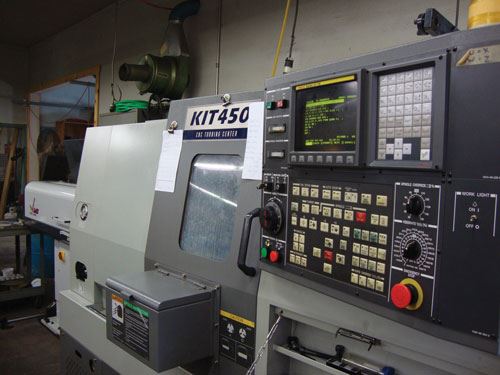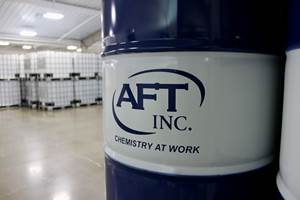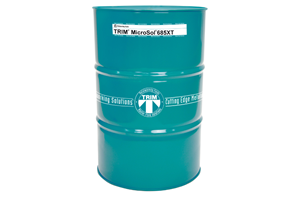Long-Lasting Coolant Reduces Costs, Downtime
This shop provides a case in point of the substantial savings that can be realized with the proper coolant formulation. Rustlick Ultracut Pro, available from ITW Rocol North America, lasted twice as long in the sump than the shop’s previous coolant, leading to significant operating and maintenance cost savings.
Although costs resulting from changing coolant can be substantial, they are frequently overlooked. That wasn’t the case at contract manufacturer Precision Methods Incorporated, where management realized just how quickly these costs can compound. Last year, the company began searching for a new coolant formulation that would reduce expenses associated with downtime during change-outs and the disposal and replacement of old coolant. Ultracut Pro from Rustlick, a brand of ITW Rocol North America (Glenview, Illinois), ran at a lower concentration and lasted longer in the sump, leading to significant savings in maintenance and operating costs.
Operating out of a 10,000-square-foot facility in central Connecticut, PMI supplies parts to the medical, aerospace, electronics, fiber optics and control industries. Although the shop specializes in Swiss screw machining—the company says it excels in producing precision threaded components—it also includes in-house facilities for CNC milling, CNC turning, centerless grinding, screw captivation, thread rolling and assembly operations. Capacity is sufficient for machining parts in most metals as well as plastics. Products manufactured here range from 3/64 inch to 10 inches in diameter, and tolerances range to ±0.0001 inch.
Implementing Ultracut Pro throughout the shop was easy, says PMI’s Tim Cocchiola. "We started using the new coolant on one of our CNC turning centers, a Hyundai-Kia KIT450. It has a small sump, maybe 20 to 25 gallons, and the transition from the former coolant went very smoothly."
Introduced in 2009, Ultracut Pro is available in 5- or 55-gallon containers with chlorinated EP additives or chlorine-free EP additives, with the latter recommended for use on titanium. The coolant consists of long-lasting, water-
soluble oils with new additives formulated specifically to provide maximum biostability and performance.
Specifically, these additives prevent fungal and bacterial growth. In fact, the manufacturer says independent lab studies performed during the past 12 months show that compared to previous-generation products, the formulation improves resistance to bacteria and fungus by factors of three and five, respectively. The additives also make the coolant safe for a wide range of materials, including steel, aluminum, brass, bronze and copper, without the risk of staining. Further contributing to versatility is the coolant’s high lubricity and rust protection, which make it suitable for improving performance on both
light-and heavy-duty cutting and grinding applications.
Don Beyer of DGI Supply, a Rustlick distributor, introduced PMI to the coolant and helped with its implementation. "Their main concern was cost savings," Mr. Beyer recalls about PMI’s impetus for converting to a new coolant formulation. "In 2009, plant managers looked closely at all of their costs, and they began scrutinizing coolant change-overs and the costs associated specifically with that."
Mr. Beyer started by doing a simple analysis comparing the cost of the shop’s previous coolant with UltraCut Pro, revealing a total potential savings of more than 20 percent. He then explained the formulation’s performance benefits, including the fact that the coolant could run at a lower concentration for some applications. On average, Ultracut Pro runs at 25:1, compared to a 15:1 ratio for most other coolants. That translates to less coolant use and additional
savings.
So far, the coolant has been implemented in two sumps at PMI, and the company intends to expand that to a range of other CNC machines in 2011. Cost savings from the longer-lasting formulation have been substantial. For example, the shop cites the minimum cost of changing coolant in a machine’s sump at $373, so it has saved at least that amount per machine this year (the previous coolant would have been changed once already).
Improved coolant life translates to other benefits as well. Fewer change-overs mean less machine downtime, saving the shop an estimated $124 per machine (based on an average of 2 hours of downtime at a cost of $50 per hour, as
well as a $12 per hour labor rate). Likewise, the shop saves on coolant disposal costs estimated at approximately $180 per change-over (based on an average per-gallon disposal cost of $3 for a 60-gallon sump). The shop also spends less on coolant replacement, which costs $69 per 60-gallon sump (when running the coolant mixture at 20:1 and taking into account a $23 average cost per gallon of concentrate). Moreover, the formulation’s resistance to bacteria and fungus saves money because tools don’t need to be changed as frequently compared to the previous solution.
"The major benefit is the coolant life improvement, which I originally sold to be at least 30 percent," Mr. Beyer says. In fact, that figure is actually closer to 100 percent. "PMI used to change the coolant every six months. The new coolant has been in the sumps for a year now, and it’s still running strong."
Related Content
AFT's Semi-Synthetic Coolant Extends Sump Life
Advanced Cool 2200 provides high visibility while machining, keeping the machine and parts clean with no odor issues.
Read MoreMaster Fluid Solutions Semisynthetic Coolant Inhibits Corrosion
Trim MicroSol 685XT is designed to provide enhanced corrosion inhibition on all ferrous and nonferrous metals.
Read MoreJorgensen's Coolant Collection System Eliminates Sludge Build-Up
The PermaClean system adds agitation to the coolant collection system or holding tank and prevents particulates from settling.
Read MoreSTLE To Host Metalworking Fluid Management Program
STLE’s program is a two-and-a-half-day education program offering a comprehensive overview of metalworking fluid management.
Read MoreRead Next
The Cut Scene: The Finer Details of Large-Format Machining
Small details and features can have an outsized impact on large parts, such as Barbco’s collapsible utility drill head.
Read More3 Mistakes That Cause CNC Programs to Fail
Despite enhancements to manufacturing technology, there are still issues today that can cause programs to fail. These failures can cause lost time, scrapped parts, damaged machines and even injured operators.
Read More
















.png;maxWidth=300;quality=90)
.png;maxWidth=300;quality=90)










